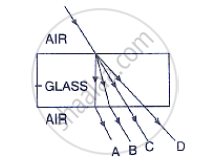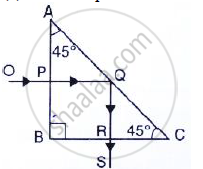Advertisements
Advertisements
प्रश्न
Light of a single colour is passed through a liquid having a piece of glass suspended in it. On changing the temperature of liquid, at a particular temperature the glass piece is not seen. When is the glass piece not seen?
उत्तर
The glass piece is not seen when the refractive index of liquid becomes equal to the refractive index of glass.
APPEARS IN
संबंधित प्रश्न
Define refraction and state the laws of refraction.
Why do we get a spectrum of seven colors when white light is dispersed by a prism?
Write the relation between the angle of incidence and the angle of refraction for a medium.
How does the angle of minimum deviation produces by a prism change with increase in :
the wavelength of incident light
A ray of light is passing from a transparent medium 1 to another transparent medium 2 (i) Speed up (ii) slows down. In each case, state whether the refractive index of medium 2 is equal to, less than or greater than the refractive index of medium 1.
In fig 4.18, name the ray which represents the correct path of light while emerging out through a glass block.

A ray of light OP passes through a right angles prism as shown in the adjacent diagram.
(a) State the angles of incidence at the faces AC and BC.
(b) Name the phenomenon which the ray suffers at the face AC.

Why upper surface of water contained in a beaker and above eye level appears silvery?
